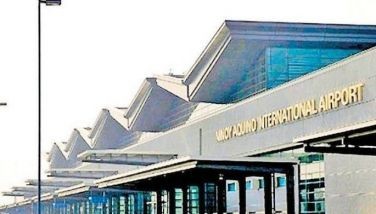Telcos grappling with Internet telephony
December 11, 2000 | 12:00am
HONG KONG – In late 1998, the brothers Chen, proprietors of a small computer shop in Fujian province in southern China, were hauled off to jail for selling Internet Protocol (IP) telephony services to their clients. Chinese authorities insisted that the Chens had broken the law by allowing customers to make international calls at half the rate of China Telecom. The Chens argued though that IP telephony fell outside of the information ministry’s existing telecom regulations, and won in the appeals court.
The Chens’ experience, it seems, reflects the way public telecom companies (telcos). And policy-makers around the world have been grappling with the technical, economic and regulatory aspects of IP telephony, defined as the transmissions of voice over the public Internet or over private, managed networks (VoIP). Some see IP telephony as becoming a key technology in the convergence of circuit-and packet-switched networks, while others are alarmed by the danger it poses to the revenue flow and monopoly status of incumbent telcos.
The International Telecommunication Union (ITU), in a report released here, says IP telephony has grabbed the attention of policy-makers, regulators and the industry because the Internet and other IP-based networks are increasingly being used as alternative to originate, transmit and terminate voice and data transmissions that otherwise, would be carried by the public switched telephone network (PSTN).
The reason for IP telephony’s growth is simple: it makes a routing of long-distance and international traffic cheaper, something consumers have taken advantage of but which public telcos have to deal with because it eats into their profit margins.
The concern is founded. The ITU estimates that the total volume of VoIP traffic carried over international networks in 2000 will be about 4 billion minutes, or about 3.2 percent f the global total, from 0.2 percent in 1998 and 1.6 percent in 1999. By 2001, the figure is 5.5 percent.
In the Philippines, the ITU says VoIP traffic accounted for 34 million minutes in 1999, or 2 percent of total traffic to the United States. With a settlement rate of 29 cents with the US, Philippine public telcos "lost" $10 million or 5 percent of total in payment from the US.
In the Southeast Asian region, this compares with 17 million minutes Malaysian telcos lost to VoIP traffic, worth about $3 million or 13 percent of in payment from the US. VoIP traffic in Singapore is placed at 51 million minutes valued at $8 million.
"What is more significant, however, is not so much the total volume of traffic as the rate of growth, which continues to be exponential at a time when overall international traffic growth appears to be slowing. It is also clear that the market is still far from mature," the ITU report states.
An indication of this, the ITU notes, is that DialPad.com, which began advertising in October 1999 "free" PC-to-phone calls from anywhere in the world to phone subscribers in the United States, claims to have carried some one billion calls, both domestic and international, in its first year of operation, from its 10 million registered users.
According to the ITU, IP telephony started among computer hobbyists in 1994 when it became possible to transmit voice messages from one PC user to another, who both had multimedia PCs and the same software and were logged on simultaneously. Beginning about 1996, though, PC-to-phone connection – transmitting voice messages originating from the public Internet to telephone subscribers on the PSTN – was realized. For the ITU, this development had a three-fold significance:
• From just a few tens of millions of PC users with multimedia PCs and IP telephony software, the potential market grew to include hundreds of millions of fixed line and mobile telephone users.
• Both users no longer had to log on simultaneously but merely use the ringing mechanism of the telephone to announce a call was waiting.
• PC-to-phone telephony created new market opportunities notably for intermediary service providers and equipment manufacturers.
The ITU says the market evolved in 1997 when IP telephony became "respectable" with giant telecom manufacturers and vendors making preliminary excursions into the market, basically phone-to-phone IP service (one of what the ITU calls the "flavors" of IP telephony).
With its tremendous growth and impact on telcos, IP telephony is being dealt with differently in various countries, depending on its state of development and degree of competition.
For carriers, the ITU says the "economies are much more complex," while for policy-makers and regulators, "the question of whether to permit or ban different forms of IP telephony is a sensitive one."
Nevertheless, whatever the responses are, the realities are there. For instance, the International Data Corp., a market research company, estimates that the IP telephony market generated traffic totaling 2.7 billion minutes in 1999 and will expand to about 135 billion minutes, with revenues of $19 billion, by 2004. (To be continued)
The Chens’ experience, it seems, reflects the way public telecom companies (telcos). And policy-makers around the world have been grappling with the technical, economic and regulatory aspects of IP telephony, defined as the transmissions of voice over the public Internet or over private, managed networks (VoIP). Some see IP telephony as becoming a key technology in the convergence of circuit-and packet-switched networks, while others are alarmed by the danger it poses to the revenue flow and monopoly status of incumbent telcos.
The International Telecommunication Union (ITU), in a report released here, says IP telephony has grabbed the attention of policy-makers, regulators and the industry because the Internet and other IP-based networks are increasingly being used as alternative to originate, transmit and terminate voice and data transmissions that otherwise, would be carried by the public switched telephone network (PSTN).
The reason for IP telephony’s growth is simple: it makes a routing of long-distance and international traffic cheaper, something consumers have taken advantage of but which public telcos have to deal with because it eats into their profit margins.
In the Philippines, the ITU says VoIP traffic accounted for 34 million minutes in 1999, or 2 percent of total traffic to the United States. With a settlement rate of 29 cents with the US, Philippine public telcos "lost" $10 million or 5 percent of total in payment from the US.
In the Southeast Asian region, this compares with 17 million minutes Malaysian telcos lost to VoIP traffic, worth about $3 million or 13 percent of in payment from the US. VoIP traffic in Singapore is placed at 51 million minutes valued at $8 million.
"What is more significant, however, is not so much the total volume of traffic as the rate of growth, which continues to be exponential at a time when overall international traffic growth appears to be slowing. It is also clear that the market is still far from mature," the ITU report states.
An indication of this, the ITU notes, is that DialPad.com, which began advertising in October 1999 "free" PC-to-phone calls from anywhere in the world to phone subscribers in the United States, claims to have carried some one billion calls, both domestic and international, in its first year of operation, from its 10 million registered users.
• From just a few tens of millions of PC users with multimedia PCs and IP telephony software, the potential market grew to include hundreds of millions of fixed line and mobile telephone users.
• Both users no longer had to log on simultaneously but merely use the ringing mechanism of the telephone to announce a call was waiting.
• PC-to-phone telephony created new market opportunities notably for intermediary service providers and equipment manufacturers.
The ITU says the market evolved in 1997 when IP telephony became "respectable" with giant telecom manufacturers and vendors making preliminary excursions into the market, basically phone-to-phone IP service (one of what the ITU calls the "flavors" of IP telephony).
For carriers, the ITU says the "economies are much more complex," while for policy-makers and regulators, "the question of whether to permit or ban different forms of IP telephony is a sensitive one."
Nevertheless, whatever the responses are, the realities are there. For instance, the International Data Corp., a market research company, estimates that the IP telephony market generated traffic totaling 2.7 billion minutes in 1999 and will expand to about 135 billion minutes, with revenues of $19 billion, by 2004. (To be continued)
BrandSpace Articles
<
>
- Latest
Latest
Latest
December 1, 2024 - 3:59pm
December 1, 2024 - 3:59pm
November 18, 2024 - 12:00am
November 18, 2024 - 12:00am
November 12, 2024 - 9:00am
November 12, 2024 - 9:00am
November 11, 2024 - 1:43pm
By EC Toledo | November 11, 2024 - 1:43pm
November 6, 2024 - 7:16pm
November 6, 2024 - 7:16pm
Recommended





























